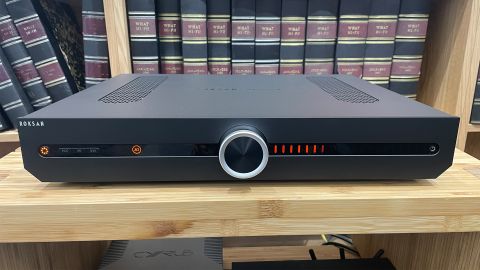Roksan has always done things a little differently. From the Xerxes to the Caspian, the brand’s products have been defined by bold design, strong engineering and hugely entertaining sound. The new Attessa range hopes to capture that Roksan flair across its sonic and visual characteristics – can it succeed?
The Roksan Attessa Streaming Amplifier (tested at £1499 / $3199 / AU$3499) we have on test here is very much a modern hi-fi product that combines amplification, DAC, streaming, preamplifier and even a phono stage into just one box – you just have to add speakers.
Streaming amplifiers (or all-in-one just-add-speaker systems, but that’s too much of a mouthful) of this kind have been rising in popularity recently as a lifestyle-friendly alternative to a traditional separates system, and we’ve heard great examples from the likes of Cambridge Audio, NAD, Bluesound, Marantz, Naim and more. It’s a lot of components to cram into one box, but can Roksan make a dent and stand out from the crowd?
Build & design
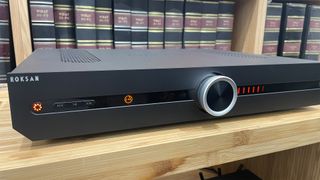
In looks alone, the Roksan is one of the more stylish one-box streaming amplifiers we’ve come across. The steel and aluminium body is understated, sleek and well made, but it’s the central control dial and minimal OLED display across the unit that gives it visual interest.
It’s a lovely thing to use, too. The dial controls the unit’s volume, with red bars appearing on the right hand side to show the level. The subtly glowing bars are clear but not blinding in a dark room; overall, it looks striking against the black finish of our review sample. A silver finish is available too.
On the left of the dial you’ll see icons for the input chosen, and you can select the inputs by pushing that main dial and scrolling. The turning action is nicely weighted and smooth, and there is a pleasing haptic feedback when cycling through the various inputs. There are many other hi-fi units that use multi-function-dials, but we think Roksan’s implementation is one of the more elegant designs.
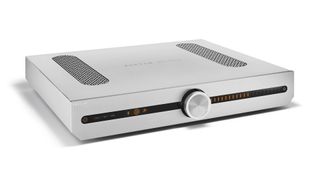
Sources Bluetooth, AirPlay 2, Tidal Connect, Spotify Connect, Internet radio, Amazon Music, Qobuz, Deezer
Network Wi-fi, ethernet
Inputs Optical x2, Coaxial x2, Line level RCA x2, Phono MM
Outputs Pre, Sub
Headphone output? Yes (3.5mm)
Max file resolution 24-bit/192kHz PCM
Dimensions (hwd) 7.6 x 43.2 x 34.6cm
Weight 10.48kg
Finishes x 2 (black, silver)
Even more pleasing is the ability to assign different logos to each input. So instead of just A1 or D1, you can choose pictorial icons of a TV, CD disc, vinyl record or games console to indicate the different sources you’ve connected the Attessa to. It’s a nice touch that makes the Attessa feel more customised to you, giving it a bit of personality otherwise missing from many other hi-fi products of this type. It also means you don’t have to remember which input is connected to which source, making it easier to choose exactly the source you want on the fly.
Some might prefer a large, colourful screen that shows off album artwork – such as in the Cambridge Audio Evo 150 and the Naim Uniti Atom – but we find the Attessa’s minimal display to be a clever alternative that’s informative and sophisticated.
Inside, the Attessa Streaming Amplifier is powered by 80 watts per channel (into 8 ohms) of class A/B amplification, while the tried-and-tested third-party BluOS platform handles all things streaming.
You do need to download Roksan’s own MaestroUnite app to initially set up the Attessa – this is an additional step but it’s worthwhile keeping the app saved as you’ll get firmware updates through here. If you have a full Roksan Attessa system (including the series’ matching CD player, turntable or standalone integrated amplifier), this app will come in handy.
For day-to-day use, however, it’s the BluOS app you’ll need to control all your streaming sources, music playback and more. There are small buttons on the unit itself to control music playback, but we find the included remote control (small but perfectly functional and responsive) and BluOS app the best ways to control the Attessa and your music.
Features & connectivity

Set-up is swift and painless, even with using two apps – that’s not always a given with streaming products, and the network connection remains blissfully stable and stutter-free throughout our weeks of testing the Attessa.
You can connect the streaming amp to your home network using wired Ethernet or wi-fi, while the unit also supports AirPlay 2 and Bluetooth. The one gaping omission is Google Chromecast, which may be a deal breaker for non-Apple households who prefer this easy casting method. On the other hand, you get access to a huge number of popular music streaming services and internet radio options through the BluOS app, but the essentials of Spotify Connect, Tidal Connect, Amazon Music and Deezer are there.
If you have music stored on NAS devices or laptops, the Roksan Attessa will be able to read these when connected to the same network, although bear in mind that the BluOS platform doesn’t support the easy-access DLNA or UPnP protocols, so you’ll need to input your drive’s file name/path into the app. It’s a little fiddly, but once you’re up and running it’s all plain sailing. We managed to connect both our Naim and Melco drives with no hiccups.

There is a decent spread of physical connections, including two inputs apiece for optical, coaxial and line level RCA. You can directly connect a turntable to the phono MM input, and there is a 3.5mm headphone jack on the front panel. There’s no HDMI input, as we’ve increasingly started to see (and see oft-requested) on such products, but you can add a subwoofer if you need extra oomph for your movies.
In terms of high-resolution file support, the Attessa’s internal DAC (a Burr Brown chip) can handle files up to 24-bit/192kHz PCM and it can decode MQA files. Those with a large DSD file library will be disappointed to know that it doesn’t support DSD natively, but it can play converted DSD files via the BluOS desktop app only. There are rival just-add-speaker systems – including cheaper models – that have wider file support, so it’s worth thinking carefully about whether the Attessa meets your digital library requirements. As most hi-res files you can download are available within the Rokan’s parameters, however, we think it will suit most but the very dedicated digital music users.
Sound
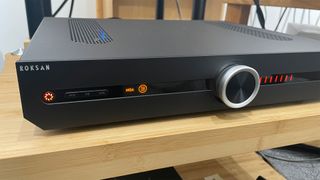
The Attessa plays nicely with all sources we plug into it during testing. We connect our two NAS drives, our reference Cyrus CDi CD player and Technics SL-1000R turntable, and stream from an iPhone/iPad, and the unit switches between all inputs smoothly. We plug the Roksan into our reference speakers, the ATC SCM50, but also use the more price-appropriate KEF LS50 Meta speakers for the majority of our testing. To try the headphone stage, we use the Beyerdynamic Amiron over-ears.
The Roksan Attessa is a wonderfully genial performer no matter what you play. It has such a likeable sonic personality from the get-go, that we find ourselves happily playing song after song through the unit. There is a decent amount of body and solidity to the sound, ample detail and clarity – all good hallmarks for when you’re listening to a wide variety of music, from John Williams to Yard Act, Taylor Swift to Eminem.
The Attessa’s greatest strength is that it has a lively sense of agility and rhythm. Eminem’s rapid-fire lyrics on Godzilla (feat. Juice WRLD) are delivered with a level of speed and nimble footing that’s admirable, while the strings and woodwind in Schindler’s List and Catch Me If You Can soundtracks are undulating, fluid and musically cohesive. The Roksan Attessa doesn’t get too hung up on analysing every drop of detail from a track, preferring to prioritise communicating the essence of a song. A sweet midrange and healthy low-level dynamics make voices sound particularly appealing, as we hear with Justin Vernon’s deep, earthy vocals on Exile. It may not be the most transparent piece of hi-fi equipment, but we find ourselves drawn to the Attessa’s pizzazz and energy.

Dynamically, we wish the Attessa would offer greater contrast and reach when it comes to expressing orchestral sweeps and subtler interplay of instruments. Play Duel Of The Fates from Star Wars Episode 1 or Massive Attack’s Angel, and we yearn for a greater sense of momentum and more expressive large-scale dynamics to fully convey the hair-raising choral arrangements and brooding sense of tension in the respective songs. Simpler piano compositions such as Whist by Chilly Gonzales sound sweet and flowing, but we’d love for the Attessa to eke out subtler textures and deeper resonances so the piano sounds more realistic. There’s a good sense of space and organisation, and nothing sticks out unduly at either side of the frequency range. Compared with rivals at this price level, the Marantz Model 40n will offer a bigger, bolder and more powerful soundstage, but it isn’t quite as engaging or rhythmically adept as the Roksan.
The Roksan’s affable approach works especially well when handling various sources. You do get the expected drop in sound quality when switching from hi-res files to a Bluetooth stream, but the Roksan’s friendly manner and agile footing remain present through all. The phono stage’s performance is decent for its type and retains the same character, although it loses a touch of precision and clarity around the leading edges of notes – as does the headphone stage – but it continues to perform with good-natured zeal and appealing musicality.
Verdict
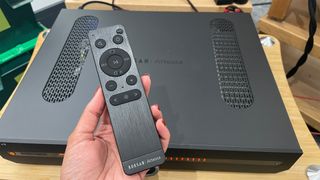
It may not be an all-rounder but, despite the chinks in its sonic armour, we find the Roksan Attessa streaming amplifier to be very likeable and enjoyable. You can tap your foot along to the music and, if so inclined, sing along to your playlists, which isn’t always the case with products we test. It’s a stylish, well-featured system that is lovely to use, and we find it has a dash of that distinct personality that we have long liked about Roksan’s products. Paired with a good pair of speakers that complements its sonic style, the Attessa streaming amplifier is a modern hi-fi system that is worth considering.
SCORES
- Sound 4
- Build 5
- Features 4
MORE:
Read our Cambridge Audio Evo 150 review
Check out the best hi-fi systems we recommend
The Marantz Model M1 could be the hi-fi streaming amplifier I've been waiting for
Should you buy a streaming amplifier? Here are 3 key pros and 2 cons to consider
